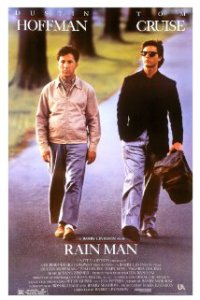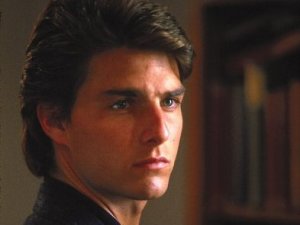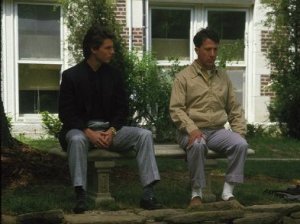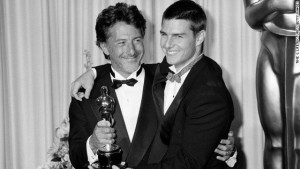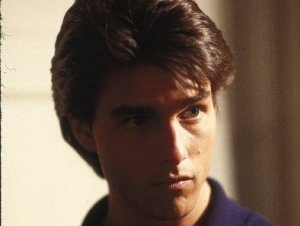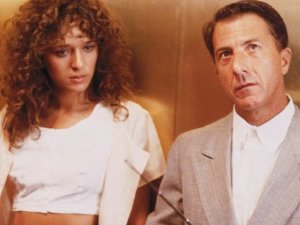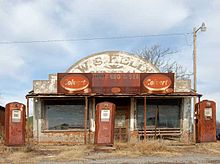Rain Man ***** (1988, Dustin Hoffman, Tom Cruise, Valeria Golino) – Classic Movie Review 2064
Director Barry Levinson’s four Oscar-winning 1988 drama is a triumph, winning some of the most important of the 1989 Academy Awards for Best Picture, Best Actor, Best Director and Best Original Screenplay. It also won the Golden Bear at the 39th Berlin International Film Festival.
The wise and witty script by Barry Morrow (screenplay/story) and Ronald Bass (screenplay), plus the shrewd pairing and canny performances of the then young heart-throb Tom Cruise and old favourite movie star Dustin Hoffman, help to turn this long, serious story into a crowd-pleasing box-office winner. Unusually, it was shot in sequence, roughly following the actual road trip that the characters take, with nine weeks of filming on location.
Hoffman won his second Best Actor Oscar for his tour de force acting as a withdrawn autistic savant called Raymond Babbitt. Noticeably, Cruise was completely ignored by the Academy voters – he wasn’t even nominated – but he isn’t far behind Hoffman in a strong performance in much less showy role as Raymond’s abrasive and selfish yuppie car salesman brother, Charlie. His estranged father has died and bequeathed a fortune to Raymond, whom Charlie didn’t even know existed, and only his car and collection of rose bushes to Charlie – and Charlie plans to do something about it.
So Cruise’s Charlie then kidnaps Hoffman’s Raymond and drives him cross country to Los Angeles to get his hands on their late father’s money from his multimillion-dollar estate. Valeria Golino co-stars as Charlie’s girlfriend, Susanna.
Barry Morrow’s story may be rather unwieldly and somewhat un-dramatic but it allows director Levinson to make sharp and quirky observations on human behaviour and the American way of life in the 80s. With the un-dramatic, talky nature of the plot, it’s easy to see why Hoffman and Cruise doubted the movie’s potential and renamed it Two Schmucks in a Car. Hoffman wanted out three weeks into filming, telling Levinson: ‘Get Richard Dreyfuss, get somebody, Barry, because this is the worst work of my life.’
[Spoiler alert] It has a big emotional finish and it is impossible not to feel elated when Hoffman’s Raymond breaks the bank at Las Vegas. Director Levinson plays the psychiatrist at the end of the movie determining if Raymond should stay with Charlie or not, filling in for J T Walsh, who was supposed to play him.
It is Hans Zimmer’s first Hollywood score. Levinson asked him to avoid strings which could make the film too sentimental. It was said to be Princess Diana’s favourite film.
The real-life savant Kim Peek was the main inspiration for Raymond’s character and Hoffman spent a lot of time with him. Writer Barry Morrow first met Peek in 1986 and gave his Oscar statuette to him. Raymond was also partly based on Bill Sackter, a good friend of Morrow who was the subject of Bill, an earlier film written by Morrow.
The script was first offered to Bill Murray to play the title role and Hoffman was to play the part of Charlie Babbit. Cruise then landed the title role with Hoffman as Charlie, but Hoffman swapped to play Raymond after being moved to tears seeing a savant named Leslie Lemke. When rehearsing, the stars frequently switched roles.
When Hoffman won his Oscar, he hugged his former New York roommate Gene Hackman (who was nominated for Mississippi Burning) as he left his seat for the podium where he warmly mentioned Hackman in his acceptance speech. He failed to mention Tom Cruise.
It was also Oscar nominated for Best Art Direction-Set Decoration (Ida Random, Linda DeScenna); Best Cinematography (John Seale); Best Film Editing; and Best Music, Original Score (Hans Zimmer). At the Golden Globes it won Best Motion Picture in the drama genre and Best Actor (Dustin Hoffman), and was nominated for Best Director (Barry Levinson) and Best Screenplay (Ronald Bass and Barry Morrow).
After a slowish start behind Twins, it ended up as the highest-grossing US film of 1988 by earning more than $172million. It grossed over $354million worldwide. It had good reviews almost everywhere, apart from New Yorker magazine critic Pauline Kael: ‘It’s a piece of wet kitsch.’
The 17 four-letter words may be edited out for TV screening.
© Derek Winnert 2015 Classic Movie Review 2064
Check out more reviews on http://derekwinnert.com/
A now-abandoned gas station and general store in Cogar, Oklahoma, was used in a scene from the film.

